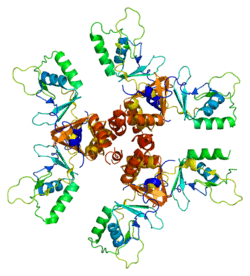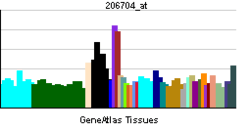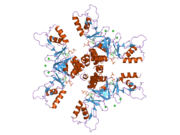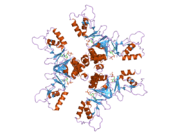CLCN5
H(+)/Cl(-) exchange transporter 5 is a protein that in humans is encoded by the CLCN5 gene.[1][2]
This gene encodes a member of the ClC family of chloride ion channels and ion transporters. Mutations in this gene have been found in Dent's Disease and renal tubular disorders complicated by nephrolithiasis.[3] Although a member of a family of chloride channels, the CLCN5 protein allows movement of protons in the opposite direction of Cl(-), thus functioning as an antiporter. [4]
See also
References
- ↑ Fisher SE, Black GC, Lloyd SE, Hatchwell E, Wrong O, Thakker RV, Craig IW (Apr 1995). "Isolation and partial characterization of a chloride channel gene which is expressed in kidney and is a candidate for Dent's disease (an X-linked hereditary nephrolithiasis)". Hum Mol Genet 3 (11): 2053–9. PMID 7874126.
- ↑ Pook MA, Wrong O, Wooding C, Norden AG, Feest TG, Thakker RV (Mar 1994). "Dent's disease, a renal Fanconi syndrome with nephrocalcinosis and kidney stones, is associated with a microdeletion involving DXS255 and maps to Xp11.22". Hum Mol Genet 2 (12): 2129–34. doi:10.1093/hmg/2.12.2129. PMID 8111383.
- ↑ "Entrez Gene: CLCN5 chloride channel 5 (nephrolithiasis 2, X-linked, Dent disease)".
- ↑ Picollo A, Pusch M (2005). "Chloride/proton antiporter activity of mammalian CLC proteins ClC-4 and ClC-5.". Nature 436 (7049): 420–3. doi:10.1038/nature03720. PMID 16034421.
Further reading
- Igarashi T, Hayakawa H, Shiraga H et al. (1995). "Hypercalciuria and nephrocalcinosis in patients with idiopathic low-molecular-weight proteinuria in Japan: is the disease identical to Dent's disease in United Kingdom?". Nephron 69 (3): 242–7. doi:10.1159/000188464. PMID 7753256.
- Scheinman SJ, Pook MA, Wooding C et al. (1993). "Mapping the gene causing X-linked recessive nephrolithiasis to Xp11.22 by linkage studies.". J. Clin. Invest. 91 (6): 2351–7. doi:10.1172/JCI116467. PMC 443292. PMID 8099916.
- Lloyd SE, Pearce SH, Fisher SE et al. (1996). "A common molecular basis for three inherited kidney stone diseases.". Nature 379 (6564): 445–9. doi:10.1038/379445a0. PMID 8559248.
- Fisher SE, van Bakel I, Lloyd SE et al. (1996). "Cloning and characterization of CLCN5, the human kidney chloride channel gene implicated in Dent disease (an X-linked hereditary nephrolithiasis).". Genomics 29 (3): 598–606. doi:10.1006/geno.1995.9960. PMID 8575751.
- Lloyd SE, Pearce SH, Günther W et al. (1997). "Idiopathic low molecular weight proteinuria associated with hypercalciuric nephrocalcinosis in Japanese children is due to mutations of the renal chloride channel (CLCN5).". J. Clin. Invest. 99 (5): 967–74. doi:10.1172/JCI119262. PMC 507905. PMID 9062355.
- Pirozzi G, McConnell SJ, Uveges AJ et al. (1997). "Identification of novel human WW domain-containing proteins by cloning of ligand targets.". J. Biol. Chem. 272 (23): 14611–6. doi:10.1074/jbc.272.23.14611. PMID 9169421.
- Oudet C, Martin-Coignard D, Pannetier S et al. (1997). "A second family with XLRH displays the mutation S244L in the CLCN5 gene.". Hum. Genet. 99 (6): 781–4. doi:10.1007/s004390050448. PMID 9187673.
- Lloyd SE, Gunther W, Pearce SH et al. (1997). "Characterisation of renal chloride channel, CLCN5, mutations in hypercalciuric nephrolithiasis (kidney stones) disorders.". Hum. Mol. Genet. 6 (8): 1233–9. doi:10.1093/hmg/6.8.1233. PMID 9259268.
- Schurman SJ, Norden AG, Scheinman SJ (1998). "X-linked recessive nephrolithiasis: presentation and diagnosis in children.". J. Pediatr. 132 (5): 859–62. doi:10.1016/S0022-3476(98)70318-X. PMID 9602200.
- Günther W, Lüchow A, Cluzeaud F et al. (1998). "ClC-5, the chloride channel mutated in Dent's disease, colocalizes with the proton pump in endocytotically active kidney cells.". Proc. Natl. Acad. Sci. U.S.A. 95 (14): 8075–80. doi:10.1073/pnas.95.14.8075. PMC 20931. PMID 9653142.
- Devuyst O, Christie PT, Courtoy PJ et al. (1999). "Intra-renal and subcellular distribution of the human chloride channel, CLC-5, reveals a pathophysiological basis for Dent's disease.". Hum. Mol. Genet. 8 (2): 247–57. doi:10.1093/hmg/8.2.247. PMID 9931332.
- Lamb FS, Clayton GH, Liu BX et al. (1999). "Expression of CLCN voltage-gated chloride channel genes in human blood vessels.". J. Mol. Cell. Cardiol. 31 (3): 657–66. doi:10.1006/jmcc.1998.0901. PMID 10198195.
- Strausberg RL, Feingold EA, Grouse LH et al. (2003). "Generation and initial analysis of more than 15,000 full-length human and mouse cDNA sequences.". Proc. Natl. Acad. Sci. U.S.A. 99 (26): 16899–903. doi:10.1073/pnas.242603899. PMC 139241. PMID 12477932.
- Moulin P, Igarashi T, Van der Smissen P et al. (2003). "Altered polarity and expression of H+-ATPase without ultrastructural changes in kidneys of Dent's disease patients.". Kidney Int. 63 (4): 1285–95. doi:10.1046/j.1523-1755.2003.00851.x. PMID 12631345.
- Wu F, Roche P, Christie PT et al. (2003). "Modeling study of human renal chloride channel (hCLC-5) mutations suggests a structural-functional relationship.". Kidney Int. 63 (4): 1426–32. doi:10.1046/j.1523-1755.2003.00859.x. PMID 12631358.
- Carballo-Trujillo I, Garcia-Nieto V, Moya-Angeler FJ et al. (2003). "Novel truncating mutations in the ClC-5 chloride channel gene in patients with Dent's disease.". Nephrol. Dial. Transplant. 18 (4): 717–23. doi:10.1093/ndt/gfg016. PMID 12637640.
- Ludwig M, Waldegger S, Nuutinen M et al. (2004). "Four additional CLCN5 exons encode a widely expressed novel long CLC-5 isoform but fail to explain Dent's phenotype in patients without mutations in the short variant.". Kidney Blood Press. Res. 26 (3): 176–84. doi:10.1159/000071883. PMID 12886045.
- Hryciw DH, Wang Y, Devuyst O et al. (2003). "Cofilin interacts with ClC-5 and regulates albumin uptake in proximal tubule cell lines.". J. Biol. Chem. 278 (41): 40169–76. doi:10.1074/jbc.M307890200. PMID 12904289.
External links
This article incorporates text from the United States National Library of Medicine, which is in the public domain.
PDB gallery |
|---|
| | 2j9l: CYTOPLASMIC DOMAIN OF THE HUMAN CHLORIDE TRANSPORTER CLC-5 IN COMPLEX WITH ATP |
| 2ja3: CYTOPLASMIC DOMAIN OF THE HUMAN CHLORIDE TRANSPORTER CLC-5 IN COMPLEX WITH ADP |
|
|
|
|
|---|
| | | | | | | | | | | see also disorders
Index of cells |
|---|
| | Description |
- Structure
- Organelles
- peroxisome
- cytoskeleton
- centrosome
- epithelia
- cilia
- mitochondria
- Membranes
- Membrane transport
- ion channels
- vesicular transport
- solute carrier
- ABC transporters
- ATPase
- oxidoreduction-driven
|
|---|
| | Disease |
- Structural
- peroxisome
- cytoskeleton
- cilia
- mitochondria
- nucleus
- scleroprotein
- Membrane
- channelopathy
- solute carrier
- ATPase
- ABC transporters
- other
- extracellular ligands
- cell surface receptors
- intracellular signalling
- Vesicular transport
- Pore-forming toxins
|
|---|
|
|



